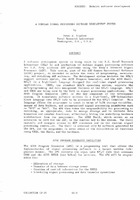A modular signal processing software development system

Abstract
A software development system is being built by the U.S. Naval Research Laboratory (NRL) to aid production of modular signal processing software for U. S. Navy airborne ASW platforms using the Navy's Advanced Signal Processor (ASP). This system, part of the ASP Common Operational Software (ACOS) project, is intended to reduce the costs of programming, maintaining, and modifying ASP software. The development system includes the SPL/Isupport software system, the ACOS Program Generator, and the ACOS Shell. SPL/I is a high-level language designed for real-time signal processing applications. CROS, the standard SPL/I operating system, supports the multiprogramming and data management features of the SPL/I language. SPL/I and CROS are being used by the Navy in signal processing applications. The ACOS Program Generator (APG) is the key component of the development system. It translates software written in a high-level, ASP-independent block language into SPLjI code to be processed by the SPL/I Compiler. This language allows the programmer to speak in terms of bulk storage variables, queues of data buffers, and parameterized signal processing primitives such as "FFT" or "AGe". The APG then takes the responsibility for generating or executing, as appropriate, code to manage storage and to initiate data transfers and complex functions; effectively hiding the underlying hardware architecture from the programmer. The ACOS Shell, which serves as an extension to CROS for the ASP, is the runtime key to the system. The Shell controls and manages access to ASP resources and is the runtime signal processing controller. The Shell is accessed only by software generated by the APG, and the programmer is never aware of the distribution of functions among CROS, the Shell, and the hardware.
Report Number
CP-25/2Source
In: Real-time, general purpose, high-speed signal processing systems for underwater research (SACLANTCEN Conference Proceedings CP-25), Part 2, 1979, pp. 24-1 - 24-9.Date
1979/12Author(s)
Rigsbee, Peter A.